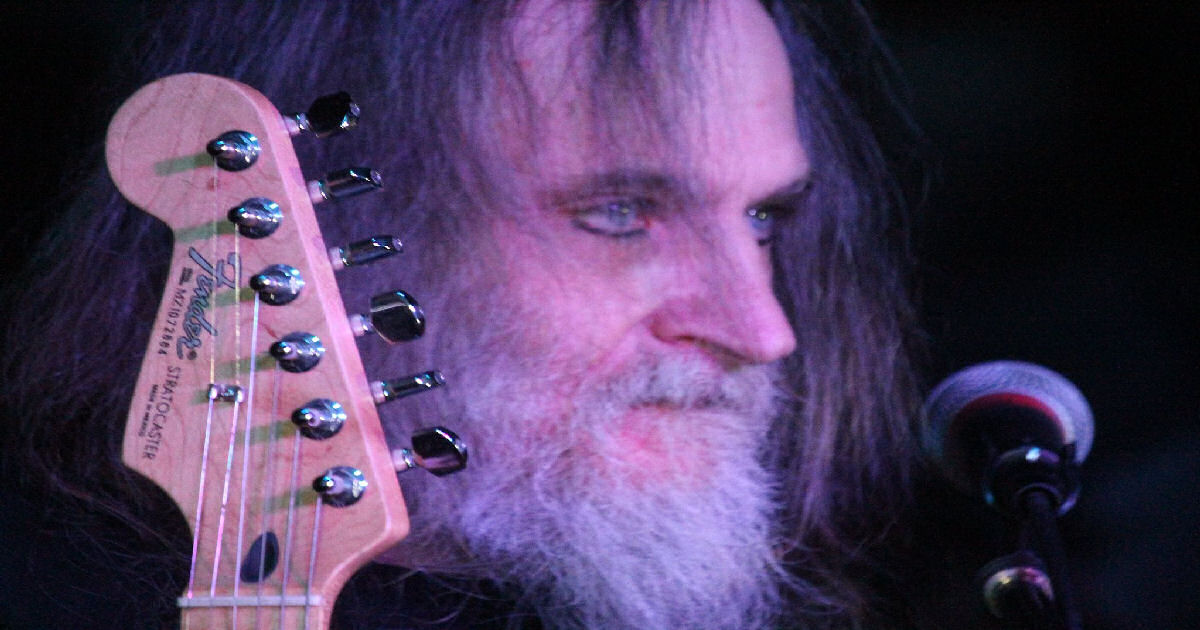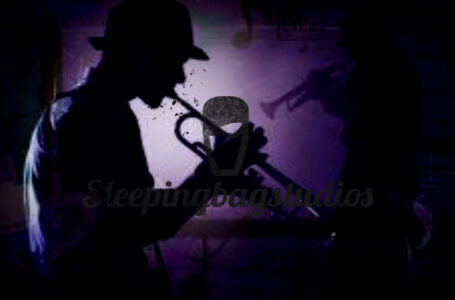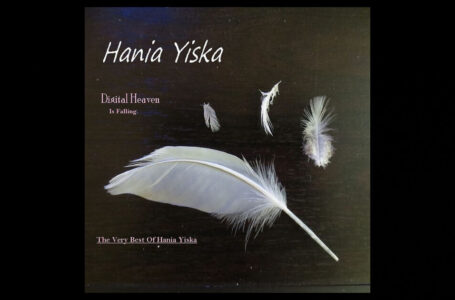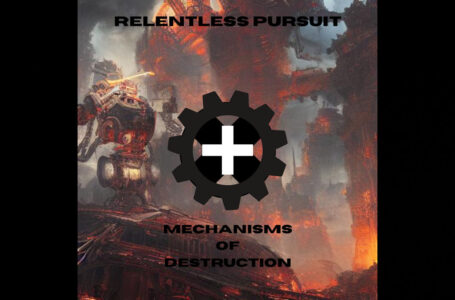The Gangsta Rabbi – Thick As A Brick / A Passion Play

The Gangsta Rabbi – Thick As A Brick / A Passion Play – Album Review
Daunting record to listen to, even on a visual level. If you take a quick look at the wav-lines on The Gangsta Rabbi’s take on Jethro Tull’s Thick As A Brick / A Passion Play records, you’ll see there’s next to no whitespace at all…which generally means the ‘wall of sound’ is coming. Considering how well we have gotten to know TGR’s music over these past years – that’s nearly a given; we know that’s coming. In consideration of the timeless classics he’s taking on and their massive degrees of difficulty, The Gangsta Rabbi had this to say:
“As I was admitted into the hospice, I still need to prove that always in the underground, I had some credibility as a musician, so I take on 2 of the most complex prog-rock pieces, Jethro Tull’s A Passion Play and Thick As A Brick. These pieces run the gamut of 6/8, 12/8, 15/8 and a little 4/4–well all i got is 4/4.”
Obviously a dangerous line to walk…I’m no math genius but I can tell you that trying to relegate all those different timing signatures to 4/4 would jeopardize a lot of what’s precious in the writing of JT’s music and signature style. It begs the question as to whether or not that does indeed speak to the ‘credibility as a musician’ – because that could potentially be argued by the purists out there that hate to hear their favorite songs tainted in any direction, let alone a switch in something so crucial as a song’s timing sequence. It also makes you wonder at why The Gangsta Rabbi wouldn’t have just then chosen to recreate music that is in the timing he’s most familiar with. Don’t get me wrong, I’m with him to a degree…my brain thinks in 4/4 almost every time I do something musical…so I get it, in a sense. Tributes and what inspires us to make them always come from a genuine place of sincerity…wanting to toast another musician or band by creating our own versions of their songs, it’s a naturally innocent and humble form of communication – a thank-you to the original creators of sorts. At the end of the day, you kind of always have to admire someone for taking on a project like that when examining the intentions through that lens…but I think it’s also important to do justice to the material at all costs. That can come about in many ways…sometimes it’s staying true to the original, sometimes it’s about ‘making it your own’ and putting an insightful spin on the ambitions of the songwriting or sound. When you listen to music from The Gangsta Rabbi, you undoubtedly step into his world and the perspective in which he both hears & plays music…no one could argue that. What I would argue for the most part, is that it’s not a change in the songs or material that he chooses to cover that needs to diversify so much as the approach itself…that concentrating on each specific element, adding less into the mix and more space into the music, refining his style…that’s actually going to lead the guy to what he’s looking for in music. Otherwise, The Gangsta Rabbi stands the potential of risking taking his 4/4 wall of sound style into battle for every song he plays…and the result, no matter how different the record, will always have the same effect on the listener. Again, for those that dig what he does, that’s aces – you like one record from The Gangsta Rabbi and you’ll assuredly like them all; but for the rest out there that can’t wrap their heads around the extremities of sound he works with…no lie, it’s some of the most demanding stuff you’ll likely ever experience when it comes to listening to music.
For example, “Sperm In The Gutter” holds nothing back from moment zero forward. Not even remotely kidding, by the time you’ve finished clicking the play button, The Gangsta Rabbi has already added in every possible sound into the mix by the very first second. By comparison to much of his past music, you can hear him singing this tune with a bit more presence and adherence to the melody; it can be tough to get past the punk-thrash nature of the blown-out mix…but again, by knowing his past material well-enough and this being my like, seventh-or-so review on his music, I can tell you for certain that you can hear him vocally better here than in most of the tunes I’ve heard before. So there’s that. The more of that we get from him, the more his genuine personality and passion play a role…there’s a benefit in being heard when you’ve got distinct character like this guy has – “Sperm In The Gutter,” for all its untamed wildness, does allow you to hear the man behind the music just a little bit more than normal.
“Pronounced Fit To Fight” starts out with an interesting sound that is different from “Sperm In The Gutter” as it begins…unique enough to know they’re separate tracks, which is…an achievement. Though he does incorporate a lot of the same techniques he applies to much of his music, “Pronounced Fit To Fight” does make a larger attempt at being different from the rest and for the most part succeeds. Of all the tunes in these two records combined, likely one of the strongest for that reason as well…there’s enough diversity in the sound and space to process at least a little bit of the madness that’s going on. On both cover-albums that he’s taken on, the second tune of the record reveals a version of The Gangsta Rabbi that’s focused on making that noticeable difference in sound from the opening tune – I think people out there will appreciate that for sure. It’s still recognizable completely to TGR’s style – but “Pronounced Fit To Fight” does audibly reach for more than most, finding success by comparison.
With The Gangsta Rabbi’s penchant for flute sounds, I can understand the appeal in covering Jethro Tull’s music…if you’re familiar with it (and you should be) then of course, that makes sense. You can hear a bit of the adjustment and struggle to adapt to the structure of “The Poet And The Painter” as he tries to fit his own style into the ideas of the original flow of the music overall, but the flute moments seem to be fairly focused and wild at the same time. On one hand you have to give TGR credit for being able to get from point-A to point-B in any of these scenarios given that mathematically, a lot of the material shouldn’t line-up at all…you might be able to hear the occasional slip along the way from the bass, the drums, or otherwise – but again, impressive somewhat that he never just completely stops full-on to reset when the math gets tough. The flute sounds on this cut are pretty lively & vibrant, the occasional on-the-fence tone, but for the most part, play a pretty engaging role on “The Poet And The Painter,” which of course, you’d hope they would as a listener or fan of Jethro Tull’s music.
“The Old Man’s Gone” coming right after “The Poet And The Painter” is where The Gangsta Rabbi begins to dip into more discernable trouble from a listening aspect and those demands upon the ears increase. Here’s where it gets tough to identify one idea from the next; I can hear enough of those subtle differences myself…but for the average everyday music listener? Not a chance they’d likely even realize that “The Poet And The Painter” ended and “The Old Man’s Gone” began, or that the two combined don’t just tumble into one longer composition. We can of course, let that slide for the Thick As A Brick experience…as many of you know, that makes sense due to the layout of the original record and sparse track listing. While that might be a natural inclination on how to approach the record, it wouldn’t have been any easier for Jethro Tull to pull that off than The Gangsta Rabbi’s attempt here…sometimes that’s just how people hear the music they listen to when it has similar movements, tones, and sounds. Admittedly, “The Old Man’s Gone” sounded like one of the tougher adaptations in the set of songs from Thick As A Brick / A Passion Play and comes out with a real distinct wall of sound that’s hard to separate.
“My Father Was A Man Of Power” has more pronunciation to the melody, which counts for something. It’s discernably more different than the previous two tracks, allowing the mind to catch up to what The Gangsta Rabbi is doing once again and the ears to process all that’s going on. I don’t know that the style of TGR is ever going to be my thing personally, but I can appreciate that he’s done more to this song once again to help it stand out. At the end of the day, the way he makes music is undoubtedly more busy than anything I’d normally listen to…but for some people out there, this kind of jam is exactly their jam. The Gangsta Rabbi has thousands upon thousands of listens at his Soundcloud page…I can definitely confirm that someone out there, or multiple someones presumably, really dig it…you might too. He adds like…a full carnival’s worth of insanity into the mix here, pounding out notes on everything he’s playing, right up to and past the red-line threshold & far beyond; that being said, the degree of wildness in this crazy cut does have its own element of captivating brightness in sound working in his favor. I mean, it’s insanity, clearly…but there are hooks buried in here that seem to stand-out in their own memorable way.
When it comes to the point of a song like “Resting Down In Cornwall” – I think we can all appreciate that the inherent madness in the attitude of a band like Jethro Tull makes sense for TGR to cover…but when it comes to the subtle dynamics of the original material, he’s struggling to capture a lot of the nuance in their music or he’s made a decisive choice to ignore it all together. Any quiet/loud moments of contrast in the original versions have been replaced by the one gear of The Gangsta Rabbi – which is loud, all the time. Does that work? Can you do that when covering someone else’s material? Does that speak to the ‘credibility as a musician’ he mentioned earlier? I’m honestly not entirely sure I could say yes to those questions, but you can decide for yourself. The transition out of “My Father Was A Man Of Power” into “Resting Down In Cornwall” is almost pure chaos…by the time this cut is over, you’ll feel like you were doing pretty much anything other than ‘resting’ whatsoever. He’s amped-up and thrashing-out at all angles here on one of this experiences most involved listens…though notably, does get pretty inventive at moments throughout the song where the clouds part for a moment and some light & space are shone into the breakdowns & such. It’s as in-your-face as sound can get…but that’s just how The Gangsta Rabbi rolls folks, that’s what he does & what he loves.
I’m hearing more of an attempt by The Gangsta Rabbi to make sure those intros come out sounding unique from the previous track for the most part, which certainly helps…but you can also unquestionably hear him dive right back into his natural tendencies on most of these tunes once they find their main energy and break out of their beginnings into the meat of the song. “The Discovery Of The Disease” still does a lot of that but does flash some smart & jarring parts that catch your attention in the right ways during the breakdown/middle of this tune. It’s an example at TGR’s most punk ultimately; even though he’s using many of the same tricks and techniques, they’re almost all amped-up as far as they could be in energy and passion on this track. And therein lies the ultimate quandary when it comes to The Gangsta Rabbi’s music – you can absolutely tell he loves doing what he does…so who am I to criticize that, or anyone else out there for that matter? It does becomes something different when you’re covering previous material…even if we are smart enough to recognize that TGR does what he does for himself and not so much out of the expectation that others will listen as faithfully as he will – he’s still putting himself in the line of fire by taking on tunes many of us recognize and hold dear, thrusting his music firmly into the realm of personal attachments to songs and speculation of all kinds.
“Light The Sun” for example, sounds like a classic cut from The Gangsta Rabbi’s collection, not so much a Jethro Tull song by comparison. A lot of that is from using that similar approach, sometimes not having quite enough definition in the tone of the vocals, the wall of sound effect…it all adds up to similar experiences that we’ve had in the past listening to his tunes. Throughout this entire record, for myself personally, that’s what I’m hearing more than anything is…that stamp of TGR’s definitive style & sound, which again is going to work for the existing fans…for those looking for a resemblance to Jethro Tull however…I think he’s severely stacked the odds against him this time around. When he covered The Who previously…that made a bit more sense in suiting his overall style…this is more of an adaptation of Jethro Tull’s music into his own sound, rather than any kind of attempt at the other way around. Production certainly plays a factor in a long-term listening experience…songs like “Light The Sun” can definitely become more exhaustive through their endless distortion, constant crunch & reverbed-vocals.
The storming pound of “The Tales Of Your Life” and the accenting flute melodies came out as one of the stronger tunes on this record. The Gangsta Rabbi is so relentlessly devout to his punk/thrash combo that the lo-fi sound can really work against the mix when the music is at its most full, but I felt like there was enough tangible definition in this tune to grab onto the original ideas of its inspiration. Intro-wise, heading into the songs, I liked the way he approached the beginnings of “Light The Sun” and “The Tales Of Your Life,” giving the ears something tangibly different and imaginative to bring us in at least before unleashing the full storm of chaos and fury of drumbeats. He’s definitely got his moments…most of the time I spend listening to The Gangsta Rabbi, I’m honestly fascinated…now that’s for several reason of course, but the ultimate point & reason being…you either can’t take your ears off of it for the fact that it’s so intensely bizarre on a constant basis, or the largess of sound simply demands your full attention. “The Tales Of Your Life” has more definition in its structure than many of the rest on this first record by comparison, even though it’s still jam-packed wall-to-wall…it’ll be enough to make the difference.
“Biggle’s Reprise” adds the kitchen sink back into the mix and has TGR roaring at full rip right from the drop once again. So many rumbles, so many drumbeats, so consistently consistent in what he does. Vocally, I think he’s put himself a bit more in front of the bombastic combinations of sound surrounding him, which I’ve felt has been a benefit each time that’s happened. He’s certainly done a decent job in communicating the madness that existed in Jethro Tull, you gotta give him that. Past the two & a half-minute mark, The Gangsta Rabbi begins to collide everything possible into one mother of a finale, which is what I’d have to imagine the process of a supernova likely would sound like if we could hear it.
From there, Thick As A Brick is over and A Passion Play begins with “Ronnie’s Pilgrim Festival.” While there’s a slight dip in volume from one record to the next and perhaps a slight increase in the production quality, but structurally and sound-wise we essentially come right back to where we left off. Save for the bass perhaps…TGR has some highlight moments on “Ronnie’s Pilgrim Festival” for smoother tones driving the backbone of the melody in this tune. This whole second record will actually go on to provide more definition and variance between tunes over the course of this section of the playlist/cover-experience we’ve got goin’ on here. I’ve never been quite sure of The Gangsta Rabbi’s penchant for pairing records in a release or what benefit that might have for the music…that hasn’t changed really. With everything being so constantly intense and demanding to listen to – I think it’s potentially unnecessary risk on the average set of ears in asking them to stick with it all for so long. If there’s a larger statement that I’m missing in combining albums as he often does, I’m missing that too. There may be something to it, there might not be…much like the songs themselves and much like the fullness of “Ronnie’s Pilgrim Festival” – my hunch is that The Gangsta Rabbi intends to maximize every opportunity for sound to exist in every way that he possibly can.
“Re-assuring Tune” is actually, fairly reassuring. Like I had mentioned way back way, earlier on in this review with “Pronounced Fit To Fight,” the second songs on both records revealed a strength in their versatility and diversity in sound. I think The Gangsta Rabbi shows more patience, focus and precision on this cut that anything we’ve experienced on this two-album recreation so far. Without a doubt a highlight in the set overall, “Re-assuring Tune” is unquestionably one of the most unique tunes you’ll hear from TGR throughout the entire twenty-one songs on Thick As A Brick / A Passion Play. The way he opens this one up…the clarity, space and precision of the movements in the music and strong relationship between instruments as “Re-assuring Tune” begins…that’s what I’m looking for personally. The added space leads to more definition and punch in the music overall, and that definition and punch lead to more impact and the ability for the song to stand-out more in comparison to the rest. Wasn’t entirely sure the breakdown around the 2:10 mark was fully-intentional…but other than that one slight moment wavering in brief trepidation, seemed like this track came out intact & looming large in sound.
“Memory Bank” has some pretty meaty guitar riffs and the accompanying flute melodies seem to make a lot more sense in the mix here this time around. The mix on this song itself is as dirtied-up as it gets, but the flute sounds bring a clarity to the melody over-top of the crunch when it’s revealed. As far as the whole flutin’ thing goes, I think you’ll find some of his best moments on “Memory Bank,” a lot of it is a subtle addition to the chaos erupting around them, but they make a valid contribution that’s noticeable, more-so towards the end. Perhaps on the thrasher “Best Friends” to follow as well…they both have solid moments where he owns the brass stick with confidence. That is what a flute is made of right? I should probably Google that rather than guess. Anyhow…you get the point…he’s finding a way to make this second record stand out a lot more than the experience with Thick As A Brick – A Passion Play is revealing more attention to detail and attempt at getting into Jethro Tull’s world rather than adapt their sound into his own. “Best Friends” would be where I’d argue that he’s using his distorted sound in a more effective way here…rather than sounding accidentally blown-out, it sounds intended and stylistic…there’s of course, a mammoth difference in that kind of listening experience. I still think the general rule of whether or not you like The Gangsta Rabbi’s style, sound, approach and perspective on music is going to dictate ultimately whether or not people connect with the record overall, but I think there’s also a noticeable difference in the quality of the tunes on A Passion Play versus Thick As A Brick.
“Critique Oblique” also speaks to that definition and difference in this second record. There are certainly still staples of the TGR sound from one wall to the other – but you really can hear that this is more faithful to the original ideas and that there’s more focus being applied here. “Critique Oblique” has a slower-burning intensity to it…The Gangsta Rabbi hasn’t slowed down too much, but enough to make that difference that allows us to take this tune in just a bit more. With some pretty gnarly low-end sounds in the melody and stops/starts in the flow, “Critique Oblique” finds a pretty entertaining vibe, it sounds menacing. Whatever it is he’s playing as the main melody line off in the distance of this tune gives the song that added layer it needs…could be a melodica, not entirely sure. Definitely without a doubt one of the radder tracks from this entire session, so far, A Passion Play is coming out with more of a chance at pulling people in with more diversity in the range of sound on songs like “Critique Oblique.” One of the stronger tunes from the set for sure…there’s much more of a controlled-chaos going on with “Critique Oblique” & a lot of distinct melody in the atmosphere that really does wonders for the music.
Arguably, one of his most underused assets is the character in The Gangsta Rabbi’s voice. I’m sure he’d likely say that the singing is the secondary element of what he does, but I think he takes the spotlight on more confidently on “The Foot Of Our Stairs,” bringing up the vocals enough to be more clearly heard. While it might not be straightforward or typical by any means, he can really add to his music by putting a bit more of himself up-front in what we hear like on “The Foot Of Our Stairs.” He doesn’t need to hit every note spot-on, he just needs to guide a few of these tunes and their melody a bit more with having them up in the mix like they are on this track – it helps. It helps definition, it helps melody, it helps the listening experience overall. I do find myself wishing at times that we could get underneath the distortion and past the drumbeats…there can quite often be some rad stuff happening, like the flute on “The Foot Of Our Stairs” or the bass-lines…which, you CAN hear, but you do have to apply a real focus when taking that time to separate one instrument from the rest when you listen to The Gangsta Rabbi’s music. Having those storming drums dialed back a lot, the distortion a little less ‘gain-filled’ will help provide some of that clarity he might be seeking, or at least assist in helping the rest of the sounds around him stand-out and allow them to play a more complementary role as opposed to being buried.
On that note, “Overseer Overture” is probably a bit too on the overdriven/overblown side of things for this guy here, but again, if that’s your thing, there’s plenty of it to go around for ya on this cut. The breakdown is an odd but effective moment…if only serving to allow us to collect our thoughts for a moment before all-out chaos ensues. The final thirty-seconds or so of “Overseer Overture” do hit those grating tones as hard as can be hit…which makes for a tough ending after a rough ride. Just as I was about to warn the general public about not letting TGR anywhere near some bag-pipes, he more or less finds a similar instrument to attack the senses with on “Flight From Lucifer.” Guitar/bass/drums-wise, I think it’s super-full, but at least it’s got good pace and a palatable sound…whatever that added layer is overtop has gotta go though brother, I have no doubt about it. Not too many sounds I can definitively say are universally tough to enjoy – but the off-putting notes and tones emanating from the top-layer melody qualify…I can’t imagine anyone out there hearing that any differently than I would, not even TGR. Other than that, I think a lot of what he was doing on “Flight From Lucifer” was coming out pretty well for him and might have been one of the stronger cuts on the record; instead it becomes a head-scratcher in wonder at what possessed the good Rabbi to lace this song with such a menacing threat. I can’t even imagine what it would be like to live next-door to The Gangsta Rabbi, aside from loud!
A Passion Play ends on the rambunctious “Magus Perde,” which savagely riffs out the final moments of The Gangsta Rabbi’s second full-album cover effort in a row. He catches a bit of a psychedelic-vibe in the floating sound of his vocals of this tune and layering in the mix. Starting, stopping, rumbling away with the thunderous amounts of sound & intensity you’ve no doubt become accustomed to at this point on the adventure, “Magus Perde” gets enough of the original across once again and could likely be considered to be one of the album’s better tunes by those listening with its expansive journey in sound roaming over quite a bit of terrain. Saving some highlights for the end, just past the four & a half-minute mark, he gets inventive with a solid breakdown & bridge in the music before heading back into full-gear for A Passion Play’s last minutes of pushing the threshold for what the mind can accept.
Does it end there? Of course not! Why stop at two albums when there’s…hmm…unlimited space actually…thinking about it, I’m not sure what would prompt him to ONLY include just two more tunes. Covering “Hymn 43” and the infamous “Cross Eyed Mary” – The Gangsta Rabbi is determined that the show must go on. By comparison to the albums, these probably aren’t bad inclusions overall…they certainly fit – but what about TGR’s music doesn’t fit from song to song or record to record? He does his own thing, love it or hate it, he can certainly call it his own and no one could ever take that away from him…I don’t know of anything else out there that sounds like The Gangsta Rabbi, truly. “Hymn 43” has some decent & memorable highlights on the bass, guitars and flute…vocally as well I’d say. “Cross Eyed Mary” is perhaps another example of TGR at his most focused and makes for a highlight finale where you can hear a lot of the original idea in this tune. That degree of familiarity counts…we recognize more of this tune…we likely still can’t sing along with it, but we can at least make out the Jethro Tull version within the madness and mayhem of The Gangsta Rabbi’s punk-thrash combo. If anything, I could have probably used a bit MORE flute from him on this final track…but suggesting he adds MORE to his material is not going to be the side of the argument you’ll usually find me on…so I’m cautious in saying that. What he does give us flute-wise in this final tune has plenty of character and charisma, it’s just used more sparingly than I thought he would use it! Vocally, he’s right up at the front of the mix, sounding bold, confident and right into the moment…which is what matters most; again, love it or hate it, the dude owns his sound like it’s everything he was meant to play – or like it was meant for him to play everything.
Find out more about the music of The Gangsta Rabbi at the official site: http://www.gangstarabbi.com
Join the thousands of bands & artists reviewed at sleepingbagstudios by clicking here!






